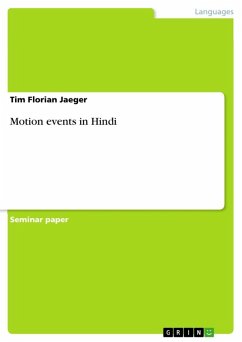Seminar paper from the year 2002 in the subject Speech Science / Linguistics, grade: A-, Stanford University (Linguistics Department), course: Lexical semantics LIN233, language: English, abstract: This squib provides a short introduction into Hindi syntax, as far as it seems to be relevant for the grammaticalization of motion events in Hindi, and a summary of the most striking facts about the way Hindi grammaticalizes motion events. Within Talmy's (1985) terminology, Hindi probably is one of the clearer cases of a PATH language. Except for some (supposedly frequently used) MANNER encoding verbs like e.g. 'run', the notion of PATH can only be evoked by PATH-verbs. The set of MANNER-verbs that are compatible with the notion of PATH seems to only contain MANNER-verbs that can be observed to be compatible with a PATH interpretation in other (PATH)-languages (cf. Eve Clark, p.c.).
Dieser Download kann aus rechtlichen Gründen nur mit Rechnungsadresse in A, B, BG, CY, CZ, D, DK, EW, E, FIN, F, GR, HR, H, IRL, I, LT, L, LR, M, NL, PL, P, R, S, SLO, SK ausgeliefert werden.




